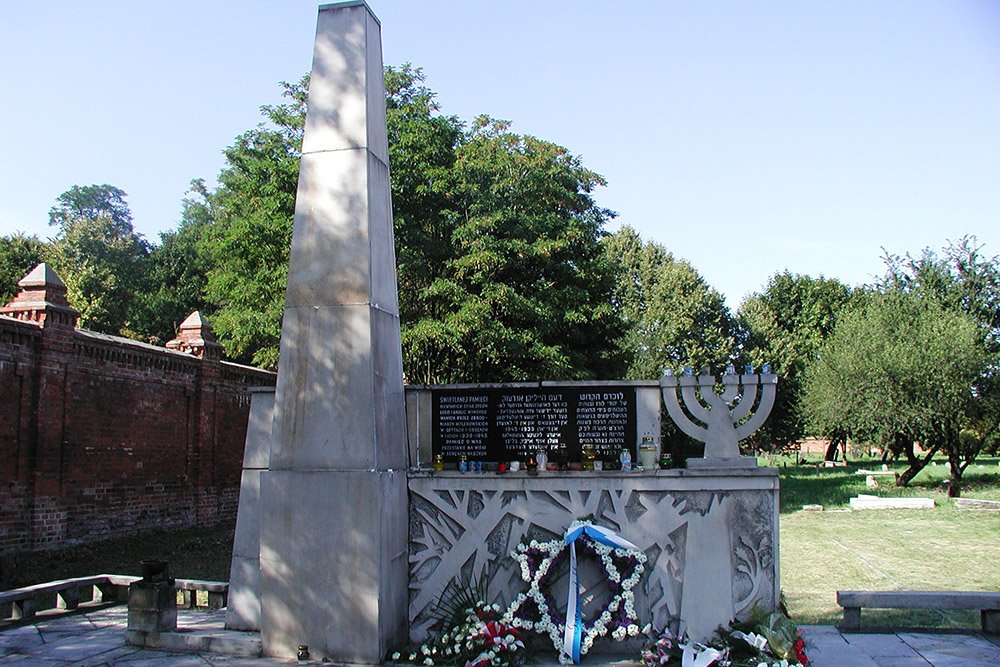Under Block Houses on Zachodnia Street: Liquidation of the Old Jewish Cemetery in Lodz, Poland
Łucja Lange, PhD | March 11, 2021
Lodz is an atypical Polish city. Historically it was viewed as the “Promised Land” and “City of Dreams”. Some say that it grew in “American speed.” Industrialization, driven by dreams of wealth and a good life, brought people from around the world, seeking new opportunities. But with this influx of new communities, there grew a need for community burial grounds.
At first, the Jewish inhabitants of Lodz had to take their deceased to Lutomiersk or Strykow, but on April 4, 1811, together with the Society of the Holy and Nursing of the Sick, a local cemetery was established at Wesola Street, which was city-center. Expanding from 6,500 square feet to nearly 7.5 acres in its 75-year active period, it was more than suitable for the Lodz Jewish community. With a gate made of red brick and an iron grille, it was viewed an aesthetically pleasing sacred space. In the first years, the cemetery was only semi-open as there was ongoing conflict surrounding higher fees with Jewish communities in Lutomiersk and Stryków.(1) By 1835 the cemetery was fully functional. However, there were some problems with so-called illegal fencing that surrounded it, so in 1871 the Funeral Society received resources to build a new red brick wall together with an ohel (an equivalent of a tomb chapel) and a “cemetery house”. By 1866, all burial lot space was purchased but synagogue supervisors were denied expansion twenty-two years later due to an existing law requiring cemeteries to be at least one-thousand steps from residential property.
An approximate outline of the cemetery boundaries on a modern satellite map, image courtesy of Jewish Cemeteries in Poland.
A new Jewish Cemetery was opened at Bracka Street in 1892—one that today many consider the second biggest Jewish cemetery in Europe. The location of the Old Jewish Cemetery in city-center of the Baluty district, then, became a problem for two reasons: 1) Jews do not exhume their dead because what is most important is hidden under the ground making moving tombstones of secondary importance; and 2) Jewish graves cannot be reused and there is no real concept of cemetery liquidation of a cemetery and therefore those interred could not just be moved. Sitting right in the middle of Lodz is about 3,871 decedents;(2) however, these numbers greatly differ from what is listed on the memorial obelisk, which is about 12,000.
After the Old Jewish cemetery officially closed in 1922, when the last burial took place, a liquidation though did happen—cemetery buildings served different purposes. For example, one of the structures became a hospital for the mentally ill. And by 1938, Arjan Maliniak, an author of an essay within a collection of essays that historicized the Old Jewish Cemetery wrote that “scattered tombstones were believed to part of the infrastructure of the old downtown Baluty district. Arjan Maliniak, who analyzed the aesthetics of the cemetery, wrote, “At present, the square of the old cemetery, closed on all sides by a low red wall and covered here and there with tall houses, is part of the old quarter of the city. The tombstones scattered without order and composition inside the cemetery are drowning in a thicket of trees, bushes and weeds, spreading sadness over a gloomy landscape, quite gray and poor in beauty gallery of the cemetery tombstones.”(3)
Poles still do not acknowledge the liquidation story of the Old Jewish Cemetery. A story wrapped in the context of WWII’s Nazi occupation is certainly likely to trigger strong emotions. The liquidation of the Old Jewish Cemetery increased during World War II in that the burial ground was partially destroyed by German troops. The hospital for mentally ill, which was in the aforementioned cemetery house, was closed in 1942 and the carpentry shed, a place used for wood storage, was established there. Complete parts of the cemetery were treated as a wood yard by German soldiers.(4) The Aryan supremacy and Nazism caused some damage to the cemetery tissue as it was no longer treated as a place of burial and remembrance. For Germans it was another place to reinvent, to change and adapt to more important goals, to sweep away from the face of the earth as it was not worth anything. The Nazi soldiers decided to dismantle the tombstones—the excavated matzevot were used to pave the streets. This move definitely shut down the cemeteries historical importance as it was no longer possible to know who was buried there and exactly where.
During WWII and under Nazi occupation, the Baluty district included the Litzmannstadt Ghetto (see also the website on the project of the Litzmannstadt Ghetto Model)—the Jewish ghetto, that was the first ghetto fully isolated from the rest of the city in occupied Poland, the largest one after Warsaw Jewish Ghetto, and the only one that survived almost until the end of the German occupation in Poland as it was liquidated in August 1944. Therefore, the cemetery was more and more forgotten.
Memorial at the Jewish cemetery of Lodz. The memorial commemorates the 43.000 Jews who perished in the Litzmannstadt Ghetto.
After WWII, a part of Lodz where the cemetery was located was destroyed and deserted. Thus, new authorities had a difficult decision to make: to rebuild or try to restore that place. And as the iron cemetery gate had been already moved to the new cemetery at Bracka Street, the final liquidation of the cemetery took place in 1949. Most of its land was allocated by the city authorities to construction areas where the estate was built. So, the block houses appeared in the place where the cemetery was situated, and a new wider road went through the Western part of the burial place. Joanna Podolska, who is the publicist that writes about multicultural Lodz and the director of The Marek Edelman Dialogue Center in Lodz, stresses that the liquidation took place unlawfully.(5) The Polish government at that time was rather nationally oriented. The main goal was to create new society that would be based on strong beliefs in unity, not diversity. It is needed to mention, that the war didn’t change the fact, that Poles were anti-Semites and after some years, there were national purges due to which Jews, Germans and other nationalities were no longer welcomed in Polish People’s Republic. The Old Jewish Cemetery, defined by Arjan Maliniak in 1938 as ordinary, had lost it value even more during II World War. It couldn’t stand a chance to be protected from oblivion.
Many people living in Lodz and even living in Baluty, don’t know the ‘secret story’ of the Old Jewish Cemetery that lies under the block houses and main street. They discover it for themselves and write about it on their blogs, sharing the mystery with others—see: “House of Graves At Wesola Street,” “The Non-Existent Jewish Cemetery in Wesola” and “Chewra-Kadisza and the Old Jewish Cemtery in Lodz”. In 2004 then city president (also called “city mayor”), Jerzy Kropiwnicki, had a stone obelisk with a plaque in four languages—Polish, English, Hebrew and Yiddish—erected in the yard at 11 Rybna Street. The plaque says: “The Old Jewish Cemetery on Wesola Street was established April 4, 1811 was in use until 1922. The German occupiers began to destroy the cemetery in 1942. The cemetery was completely destroyed by the communist authorities in the years 1949-1954. The grounds hold about 12,000 graves.” The obelisk is not the only relic of the cemetery. As Joanna Podolska wrote, the only pieces of the cemetery that are still present are a part of the brick wall near 9 Rybna Street and two lonely sarcophagi, from which the second one was moved to 42 Lutomierska Street.(6)
Between 2007 and 2008 the modernization of the tram line brought back the subject of the forgotten Old Jewish cemetery. It reminded people about the war and its victims, and the time of national tendencies in Polish People Republic due to which the cemetery was doomed to be forgotten. Subsequently, some decisions had to be made to repair the damage. After consultations with the Jewish Community and the rabbis’ committee, it was agreed that there would not be any exhumations and a steel plate should be laid to separate the graves from the tram tracks. The graves were secured with a special structure made of galvanized steel plates and reinforced concrete plates, creating an expansion gap between the ground and the track. The project was prepared by engineer Arie Klein in consultation with the Committee for the Protection of Jewish Cemeteries in Europe.7 As according to the principles of the Jewish religion, human remains cannot be tampered with if full skeletons have been preserved—and this was the case here. The cemetery must be separated with a layer of earth and air so that people do not walk on the graves.
The Old Jewish Cemetery is not the only forgotten cemetery in Lodz, but it was the biggest destroyed due to the political and cultural changes over the years. The sad story of the Old Jewish cemetery illustrates how cemeteries where the poor and common people are buried, disappear as less interesting, and without great historical meaning. The classism and anti-Semitism, together with the need of creating one-nation-country after the WWII destroy history of many generations of people, who inhibited the same city and shared the same dreams.
Notes
1. Friedman F. 1938. Stary cmentarz żydowski w świetle cyfr. [IN] Szpera J. (ed.) Stary Cmentarz Żydowski w Łodzi. Studjum monograficzne. Gmina Wyznaniowa Żydowska: Łódź, p. 151.
2. Maliniak A. 1938. Monumentica. [IN] Szpera J. (ed.) Stary Cmentarz Żydowski w Łodzi. Studjum monograficzne. Gmina Wyznaniowa Żydowska: Łódź, p. 113.
3. Podolska J. 2009. Spacerownik: Łódź Żydowska. Biblioteka Gazety Wyborczej: Łódź, p. 152.
4. Podolska J. 2009. Spacerownik: Łódź Żydowska. Biblioteka Gazety Wyborczej: Łódź, p. 152.
5. Podolska J. 2009. Spacerownik: Łódź Żydowska. Biblioteka Gazety Wyborczej: Łódź, p. 152.
About the Author
Dr. Łucja Lange is a graduate of Theatre Studies (2004) and Ethnology (2015). Has PhD in Sociology and is finishing her second PhD in Literature and Digital Humanities. Since 2020, she has been an active member of the Section for Interspecies Relations in the Polish Sociological Association and in the Institute of the Good Death, where she leads circles connected with the subjects of ecological grief and grief for non-human animals. Łucja is an assistant professor at the Institute of Sociology (University of Lodz) in Poland.


